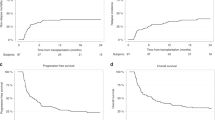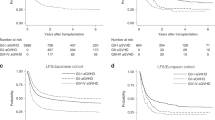Abstract
HLA matching is a critical determinant of outcomes for patients who have undergone umbilical cord blood transplantation (UCBT). Data have been published on the importance of donor/recipient HLA mismatch direction on UCBT outcomes. HLA mismatch in the graft-versus-host (GVH) direction is defined as a donor homozygous at an HLA locus, while the recipient shares one HLA Ag with the donor. HLA mismatch in the host-versus-graft (HVG) direction is defined as a recipient homozygous with the donor sharing one HLA Ag. In our study we focused on confirming, using an independent population, whether transplantation outcomes would be different when HLA mismatch direction was considered. We analyzed 1565 patients who received a single-unit UCBT for malignant disease. Median age was 15 years and 72% of patients were transplanted for leukemia. In multivariate analysis, using the 5/6 HLA-matched population as reference, one or two HLA mismatches in the GVH or HVG direction were not associated with non-relapse related mortality and survival. On the basis of our results, there is no evidence to support a change in the current practice for cord blood unit selection.
This is a preview of subscription content, access via your institution
Access options
Subscribe to this journal
Receive 12 print issues and online access
$259.00 per year
only $21.58 per issue
Buy this article
- Purchase on Springer Link
- Instant access to full article PDF
Prices may be subject to local taxes which are calculated during checkout
Similar content being viewed by others
References
Rocha V, Gluckman E . Improving outcomes of cord blood transplantation: HLA matching, cell dose and other graft- and transplantation-related factors. Br J Haematol 2009; 147: 262–274.
Petersdorf EW . Optimal HLA matching in hematopoietic cell transplantation. Curr Opin Immunol 2008; 20: 588–593.
Wagner JE, Rosenthal J, Sweetman R, Shu XO, Davies SM, Ramsay NK et al. Successful transplantation of HLA-matched and HLA-mismatched umbilical cord blood from unrelated donors: analysis of engraftment and acute graft-versus-host disease. Blood 1996; 88: 795–802.
Rocha V, Wagner JE Jr, Sobocinski KA, Klein JP, Zhang MJ, Horowitz MM et al. Graft-versus-host disease in children who have received a cord blood or bone marrow transplant from an HLA-identical sibling. N Eng J Med 2000; 342: 1846–1854.
MacMillan ML, Weisdorf DJ, Brunstein CG, Cao Q, DeFor TE, Verneris MR et al. Acute graft-versus-host disease after unrelated donor umbilical cord blood transplantation: analysis of risk factors. Blood 2009; 113: 2410–2415.
van Rood JJ, Stevens CE, Smits J, Carrier C, Carpenter C, Scaradavou A . Reexposure of cord blood to noninherited maternal HLA antigens improves transplant outcome in hematological malignancies. Proc Natl Acad Sci USA 2009; 106: 19952–19957.
van den Boogaardt DE, van Rood JJ, Roelen DL, Claas FH . The influence of inherited and noninherited parental antigens on outcome after transplantation. Transpl Int 2006; 19: 360–371.
Köegler G, Enczmann J, Rocha V, Gluckman E, Wernet P . High-resolution HLA typing sequencing for HLA-A, -B, -C, -DR, -DQ in 122 unrelated cord blood/patient pair transplants hardly improves long-term clinical outcome. Bone Marrow Transplant 2005; 36: 1033–1041.
Matsuno N, Wake A, Uchida N, Ishiwata K, Araoka H, Takagi S et al. Impact of HLA disparity in the graft-versus-host direction on engraftment in adult patients receiving reduced-intensity cord blood transplantation. Blood 2009; 114: 1689–1695.
Stevens CE, Carrier C, Carpenter C, Sung D, Scaradavou A . HLA mismatch direction in cord blood transplantation: impact on outcome and implications for cord blood unit selection. Blood 2011; 118: 3969–3978.
Szydlo R, Goldman JM, Klein JP, Gale RP, Ash RC, Bach FH et al. Results of allogeneic bone marrow transplants for leukemia using donors other than HLA-identical siblings. J Clin Oncol 1997; 15: 1767–1777.
Martin PJ, Weisdorf D, Przepiorka D, Hirschfeld S, Farrell A, Rizzo JD et al. National Institutes of Health Consensus Development Project on Criteria for Clinical Trials in Chronic Graft-versus-Host Disease: VI. Design of Clinical Trials Working Group report. Biol Blood Marrow Transplant 2006; 12: 491–505.
Glucksberg H, Storb R, Fefer A, Buckner CD, Neiman PE, Clift RA et al. Clinical manifestations of graft-versus-host disease in human recipients of marrow from HL-A-matched sibling donors. Transplantation 1974; 18: 295–304.
Kaplan EL, Meier P . Nonparametric estimation from incomplete observations. J Am Stat Assoc 1958; 53: 457–481.
Fine JP, Gray RJ . A proportional hazards model for the sub distribution of a competing risk. J Am Stat Assoc 1999; 94: 496–499.
Cox DR . Regression models and life tables. J R Stat Soc 1972; 34: 187.
Gluckman E, Rocha V, Arcese W, Michel G, Sanz G, Chan K-W et al. Factors associated with outcomes of unrelated cord blood transplant: guidelines for donor choice. Exp Hematol 2004; 32: 397–407.
Eapen M, Klein J, Sanz GF, Spellman S, Ruggeri A, Anasetti C et al. Effect of donor-recipient HLA matching at HLA A, B, C, and DRB1 on outcomes after umbilical-cord blood transplantation for leukemia and myelodysplastic syndrome: a retrospective analysis. Lancet Oncol 2011; 12: 1214–1221.
Lee SJ, Klein J, Haagenson M, Baxter-Lowe LA, Confer DL, Eapen M et al. High-resolution donor-recipient HLA matching contributes to the success of unrelated donor marrow transplantation. Blood 2007; 110: 4576–4583.
Loiseau P, Busson M, Balere M-L, Dormoy A, Bignon J-D, Gagne K et al. HLA association with hematopoietic stem cell transplantation outcome: the number of mismatches at HLA-A, -B, -C, -DRB1 or -DQB1 is strongly associated with overall survival. Biol Blood Marrow Transplant 2007; 13: 956–974.
Kawase T, Morishima Y, Matsuo K, Kashiwase K, Inoko H, Saji H et al. High-risk HLA allele mismatch combinations responsible for severe acute graft versus host disease and implication for its molecular mechanism. Blood 2007; 110: 2235–2241.
Anasetti C, Amos D, Beatty PG, Appelbaum FR, Bensinger W, Buckner CD et al. Effect of HLA compatibility on engraftment of bone marrow transplants in patients with leukemia or lymphoma. N Engl J Med 1989; 320: 197–204.
Takanashi M, Atsuta Y, Fujiwara K, Kodo H, Kai S, Sato H et al. The impact of anti-HLA antibodies on unrelated donor cord blood transplantations. Blood 2010; 116: 2839–2846.
Spellman S, Bray R, Rosen-Bronson S, Haagenson M, Klein J, Flesch S et al. The detection of donor-directed, HLA specific alloantibodies in recipients of unrelated hematopoietic cell transplantation is predictive of graft failure. Blood 2010; 115: 2704–2708.
Ciurea S, de Lima M, Cano P, Korbling M, Giralt S, Shpall EJ et al. High risk of graft failure in patients with anti-HLA antibodies undergoing haploidentical stem-cell transplantation. Transplantation 2009; 88: 1019–1024.
Acknowledgements
We thank the following authors for contribution: W Arcese, B Rio, K Boudjedir and M Labopin. In addition, Fernanda Volt, Wagnara Chaves and Chantal Kenzey for help with data collection. Funded in part by the Inserm grant TGIR0805. V Rocha is funded by National Institute Health Research-Biomedical Research Centres (NIHR-BRC) funding scheme.
Author information
Authors and Affiliations
Corresponding author
Ethics declarations
Competing interests
The authors declare no conflict of interest.
Additional information
Author contributions:
RC, PL, AR, EG and VR designed the study, prepared and analyzed data. ML analyzed data. RC, AR, EG and VR wrote the paper. GS, GM, API, GS, WA, AP, CDH, BR, FL, TOB, IY-A, MAD, NM, HB, MPS and DC provided cases for the study. RC, PL and KB prepared and verified data. All authors edited and approved the manuscript.
Rights and permissions
About this article
Cite this article
Cunha, R., Loiseau, P., Ruggeri, A. et al. Impact of HLA mismatch direction on outcomes after umbilical cord blood transplantation for hematological malignant disorders: a retrospective Eurocord-EBMT analysis. Bone Marrow Transplant 49, 24–29 (2014). https://doi.org/10.1038/bmt.2013.120
Received:
Revised:
Accepted:
Published:
Issue Date:
DOI: https://doi.org/10.1038/bmt.2013.120



